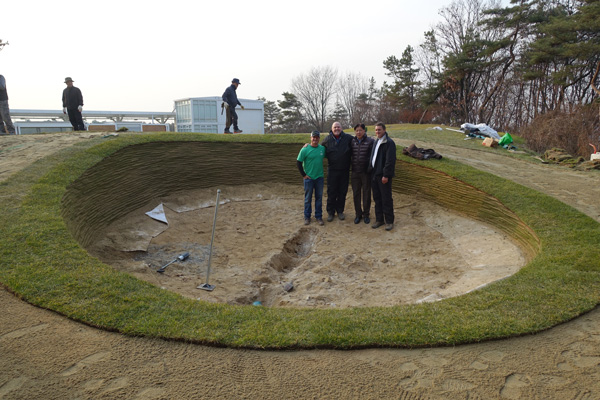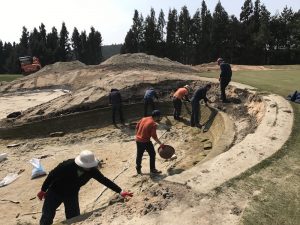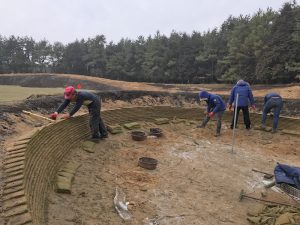Dale, PGA Tour tap Durabunker for revetted bunker job at Nine Bridges

Dave Dale (second from the left) and Steve Wenzloff (far right) pose for a photo in a renovated bunker. Photo courtesy Durabunker
The Club at Nine Bridges, Jeju Island, South Korea, Architect David Dale and the PGA Tour’s Steve Wenzloff are looking to transform a reconstruction ritual from every other year to every other decade by having Durabunker’s synthetic turf walls installed on the course.
Dale’s design at The Club at Nine Bridges, which opened in 2001, is set to host South Korea’s first U.S. PGA Tour event. The Scottish Highland-themed layout will host the inaugural CJ Cup Oct. 19-22.
Crews here had been in the habit of rebuilding its 15 revetted bunkers every 2-3 years. According to Dale, pre-tournament renovations will reduce the number of stacked-sod bunkers by a third, but he expects the Durabunker method — which utilizes re-cycled synthetic material to build/rebuild sod-wall bunker faces and edges — to increase longevity five-fold.
“We may do better than that, but the climate here is much wetter and more humid than comparable Durabunker projects we investigated — at St. Andrews in Scotland, Royal North Devon in southwestern England, at Tiburon in Florida,” says Dale, a partner with Santa Rosa, Calif.-based Golfplan. “We’ve been impressed everywhere we’ve seen it done, and we did extraordinary due diligence before finalizing this decision.
 “The playability over time is exactly what one would expect from stacked-sod, in terms of look and bounce. But the owners here are like owners anywhere: They thought it unnecessarily expensive and disruptive to rebuild with such frequency. Considering this product is built from 100 percent recycled materials, maintains design integrity, prevents sand contamination, and requires no watering, ever — there’s a lot to like.”
“The playability over time is exactly what one would expect from stacked-sod, in terms of look and bounce. But the owners here are like owners anywhere: They thought it unnecessarily expensive and disruptive to rebuild with such frequency. Considering this product is built from 100 percent recycled materials, maintains design integrity, prevents sand contamination, and requires no watering, ever — there’s a lot to like.”
Wenzloff, vice president and player liaison with PGA TOUR Design Services, was first introduced to the Durabunker product during a casual round of golf in Florida.
“It seemed like a good design solution; that got my attention,” he says in a press release. “Then we got involved with this new project in Colorado” — The TPC Colorado, scheduled to open later this year and the first new-build to use Durabunker — “where they wanted to go the revetted-bunker route. This seemed like the right solution for that environment, too.
“I had made a visit to Nine Bridges back in 2012, when we were analyzing the course as a potential President Cup site. Fast forward to the fall of 2016: I was back at Nine Bridges and I could see several of the revetted bunkers had sloughed off. It came to my attention that they rebuilt them every other year and were planning to do so again. Do the math: That’s 9-10 times they’ve gone through that process.
“Of course, we’re putting a competition in there, so we wanted to ensure they’re viable. We did a test bunker, got buy-in and decided to rebuild them all using Durabunker.”
Over the last two 15 years, Dale has authored design refinements here on nearly an annual basis. This winter, with the PGA Tour set to visit, he has refurbished bunkers, re-established the relationship between pond and putting surface (at the stunning par-3 7th) and added back tees (on the par-5 finisher, this has meant an additional 55 yards). But most of the renovations are bunker related.
“Stacked-sod bunkering has always been a feature here. In terms of terrain,” Dale explains, “the similarities between Nine Bridges and Gleneagles are pretty striking. From the outset, we wanted to accent this unique upland site in the way James Braid would have.
“But they are a maintenance headache (to say nothing of expense) if we’re replacing bunker walls every other year. We also wanted to provide players and television viewers maximum visibility. So, over the course of 15 years really, we’ve reduced the number of stacked-sod bunkers by 75 percent and rebuilt the remainders with Durabunker. We’re also removing several traditional bunkers on the course, again, to provide maximum strategic and visual impact.”
 Durabunker is poised to make more prominent inroads here in the Asia-Pacific marketplace following January’s agreement with Better Billy Bunker, whereby the latter will now serve as a sales representative for Durabunker, while Durabunker will become a certified licensed installer of the Better Billy Bunker construction method. This stands to further increase deployment of both technologies worldwide, but especially in Asia-Pacific where renovation and new construction markets are strongest.
Durabunker is poised to make more prominent inroads here in the Asia-Pacific marketplace following January’s agreement with Better Billy Bunker, whereby the latter will now serve as a sales representative for Durabunker, while Durabunker will become a certified licensed installer of the Better Billy Bunker construction method. This stands to further increase deployment of both technologies worldwide, but especially in Asia-Pacific where renovation and new construction markets are strongest.
Co-developed by Managing Director Rhydian Lewis, who is also co-inventor of all granted design patents and registered designs associated with Durabunker, the product is available in multiple bunker styles. Delivery models vary according to license agreements, meaning clubs can build Durabunker in house, or engage full contractual services form the vendor.
Nine Bridges opted for the former to prep for its latest tournament engagement. The Club has played host to numerous Korean PGA and LPGA Tour events. Indeed, Nine Bridges was instrumental in bringing the LPGA to Asia, hosting the first of four events in 2002 (what would become the LPGA KEB HanaBank Championship).
For Korean golf, this fall’s CJ Cup marks a first-ever visit from the U.S. PGA Tour, which has signed a 10-year deal with the owners at Nine Bridges, the CJ Corporation.
Want to learn more about Durabunker? Check out our May issue feature, Carpets on the walls, which takes a look at why a pair of superintendents turn to an artificial answer for stability after natural sod bunker walls became too unpredictable and expensive. Read it here.








